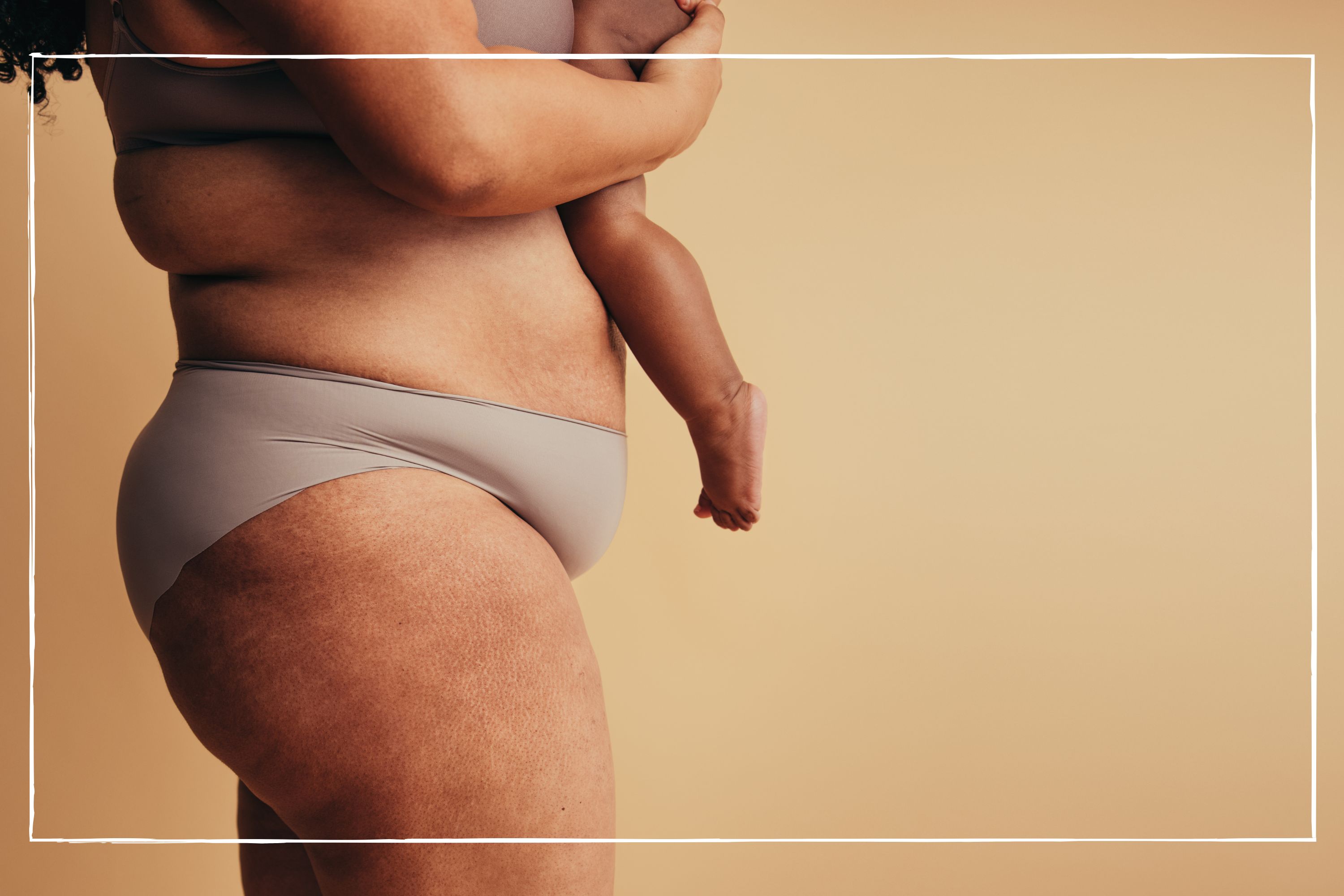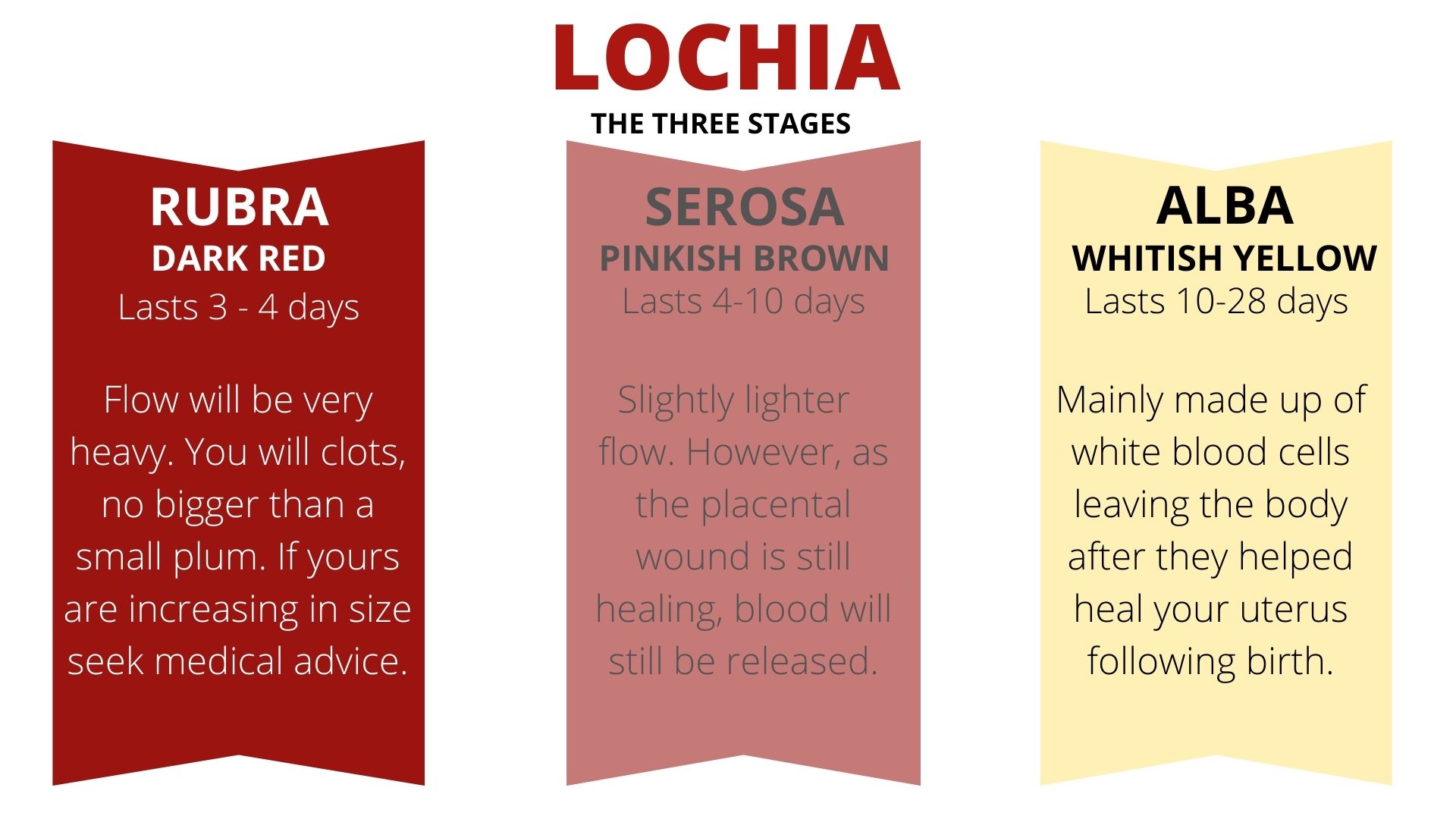Lochia: What you need to know about postpartum bleeding
Lochia is a symptom of just what your body goes through after giving birth, find out more...


Lochia is present in the days after pregnancy, while your body and mind adjusts to many changes. It's helpful to know what to expect.
As well as knowing what to expect from your first postpartum period, there's the question of the natural bleeding that occurs after childbirth. This natural bleeding is called lochia. The bleeding happens to every new mum, whether their baby was born naturally or through a C-section. Expect it to last for at least a month. "Lochia will last for up to 4-6 weeks, although more than 10% of women will experience bleeding beyond 40 days," says Sharon Gamon, midwife for the South Coast Private Midwives.
We spoke to the experts to gather all the information on the different types, how long it lasts, and the difference between lochia and your period.
Meaning of lochia
'Lochia is a combination of amniotic fluid, tissue and blood and it's completely normal,' says Mr Ellis Downes, consultant obstetrician and gynaecologist at The Portland Hospital in London (a part of HCA Healthcare UK).
"Lochia is a normal fluid passed vaginally after childbirth,' he continues. 'It's your body’s way of removing the excess blood and discharge from the uterus after giving birth. The blood will predominantly come from the area where the placenta detached itself from the uterine wall, leaving behind a raw wound that needs to heal. The endometrial lining, which thickens during pregnancy, is also released in a similar way to having your period,' he explains.
'During the nine months of pregnancy the uterus builds up a thick lining specifically to nourish and grow the baby; this then has to be shed after the birth to bring the uterus back to a non-pregnant state,' adds Tina Perridge, a midwife and co-founder of South London Independent Midwives.
Sometimes period-like cramps – or mini contractions – can come with lochia, especially if you’re breastfeeding, as this helps the uterus to contract back to its normal size. The pain is simply that: the uterus shrinking back to normal and is nothing to worry about. They occur as women experience a surge in the hormone oxytocin. This is the ‘feel good’ hormone that helps mums bond with their babies and also helps stimulate milk production.
GoodtoKnow Newsletter
Parenting advice, hot topics, best buys and family finance tips delivered straight to your inbox.
Immediately after birth, the bleeding can be heavy – so you’ll need to stock up on maternity pads or ultra-thick panty liners to absorb it. Tampons shouldn't be used at this time as internal protection can increase the risk of infection. The extra padding actually comes in quite useful as many new mums find sitting down painful after giving birth, so this cushioning helps.
It's also better to avoid sex until lochia has finished, as it can put you at risk of infection.
Lochia after c-section: is bleeding different after a C-section?
Lochia after c-section: is bleeding different after a C-section?
Women who have a Caesarean section may have less lochia after 24 hours than mums who have a vaginal delivery. This is not always the case, though. Some mums have reported very light bleeding after undergoing a Caesarean section; others have stated that it lasted longer than with their vaginal births.
If you had a Caesarean section follow the same guidelines and warning signs outlined for vaginal birth deliveries.
Lochia stages: What are the three types of lochia?
Lochia stages: What are the three types of lochia?
'Lochia rubra, lochia alba and lochia serosa are the three different stages of lochia following birth,' says Mr Downes. 'These are the recognised types of lochia, but each woman is an individual and some stages of lochia may be shorter, or longer, than others.'
Lochia rubra
'Lochia rubra occurs on days two to five [post-birth] and is when the bleeding is at its heaviest,' explains Mr Downes. 'Your blood will be red and very heavy. It's also normal to see clots during this stage. However, clots should not be larger than a small plum, so if yours are increasing in size I would recommend seeking advice from a midwife, GP or healthcare professional as soon as possible.'
'Lochia rubra can be quite heavy and, if you've been sitting or lying down then stand up, it will feel like a big rush but should then settle down again,' explains Tina.
Lochia serosa
The next stage is lochia serosa. 'Lochia serosa usually lasts for around two weeks and begins around day four after giving birth,' explains Mr Downes. 'This mixture of blood and discharge will change to a light watery pink. It will be slightly lighter than the previous days. However, as the placental wound is still healing, blood will still be released,' he says.
Lochia alba
'Finally, lochia alba starts from around week two and lasts until you are six weeks postpartum. Once you reach this stage, lochia changes from pink to a yellow/white colour, with just the occasional spot of blood. This discharge is mainly made up of white blood cells leaving the body after they helped heal your uterus following birth,' says Mr Downes.

Lochia smell
Lochia is blood so there will be a smell, which should be mild. 'Lochia odour is similar to that of normal menstrual fluid; some say it smells stale and musty,' says Sharon.
'Vaginal blood loss tends to have a slightly metallic smell; however, this should not be so strong as to make you uncomfortable,' says Mr Downes.
What's important to realise is that if this smell is offensive you may need medical help. 'It shouldn't be a really unpleasant smell as this may be a sign of infection in the uterus, especially if accompanied by pain in the abdomen,' says Tina.
What causes foul smelling lochia?
'Foul smelling lochia with a fishy smell or greenish lochia can be an indication of contamination or infection. Report this to a health care professional immediately,' warns Sharon. 'It can be treated by a course of antibiotics. Other signs of infection include chills, fast pulse rate, pain or tenderness in the tummy and high temperature.'
Mr Downes agrees: 'If your lochia smells offensive, this might indicate an infection – either in the womb or around any vaginal tears you may have sustained during childbirth. Infections may become dangerous if they are not treated, especially if the infected area is around your uterus, as this can lead to complications such as blood clots or bladder infections,' he says.
While this sounds alarming, more often than not an infection is manageable with treatment, but the sooner you get it seen to the better.
'Most often, infections just make your postpartum experience more uncomfortable and take away valuable bonding time with your baby,' says Mr Downes. 'I'd recommend letting your midwife or healthcare professional know,' he advises.
How long does lochia last and when should it stop?
'The duration for postpartum bleeding is different for each new mum,' says Mr Downes. 'However, it tends to last for around six weeks. Sometimes lochia may totally resolve in two weeks, or it may persist for 10. Lochia tends to take slightly longer to resolve after Caesarean section as the uterus may be a bit slow to involute – which means return to normal size,' he explains.
While lochia is harmless don't ignore heavy bleeding. 'If the bleeding carries on for an extended time and is becoming increasingly heavy, this could be the sign of a postpartum haemorrhage. This requires urgent medical attention,' he warns.
Lochia: Here's a guide of what to expect
After one day. Mums can expect to see fresh red or browny-red blood loss. The flow of blood may be quite heavy, soaking a maternity pad every few hours. You may pass one or two quite large blood clots. They may be as large as a plum, or you may pass several smaller ones about the size of grapes. These are just remnants of your placenta.
If you're worried, it can be a good idea to show your midwife when she comes to visit. Don’t feel embarrassed – they've seen it all before. Midwives are there to help you in the first few days of coping with a new baby. Their reassurance is essential and hugely comforting.
After one week. Your blood should now have turned a pinky brown colour. Expect the stain on your maternity pads to get smaller and lighter. You may pass little blood clots. Let your midwife know if you think you might be passing too much blood after a week.
After three weeks. Blood loss at this stage should be pale yellowish-white – or you may find there's no blood at all. Your uterus should now be almost back to its previous size. Cramping or contractions should also be coming to an end.
After six weeks. Some women may experience a small amount of brown, pink or yellowish-white discharge up to six weeks after giving birth. It may appear in small amounts daily or just occasionally. This will be the final stage of lochia discharge and shouldn’t last beyond six weeks.
Is it normal for postpartum bleeding to stop and start again?
'It's quite common for women to stop bleeding for one or so days and then start again,' says Sharon. Tina agrees: 'Yes, lochia is just like a period. It's particularly likely to increase when you start to be more active, or go for a walk early in the postpartum period. Breastfeeding can also increase the flow as the oxytocin produced by breastfeeding creates uterine contractions which push more lochia out,' she explains.
'Although the blood loss will taper off as the days and weeks go by, around a week or two after your bleeding seems to have stopped, it can suddenly start back up again,' says Mr Downes. 'This is part of a normal process where the placental site scab starts to come off. This additional bleeding should only last a few extra days.'
Lochia or period? What is the difference?
'Lochia is used to describe the bleeding and vaginal loss after your baby is born,' says Tina, while a period is the monthly shedding of the uterus lining. There's usually a break between lochia stopping and your period starting, so expect to see your first postpartum period a couple of weeks after lochia has ceased.
If your period doesn't arrive and it's been a couple of months since you gave birth, speak to your health visitor or GP. If you breastfeed, your periods may take longer re-start. It's a myth that breastfeeding is an effective contraceptive – even if your periods haven't returned you can become pregnant again as early as three weeks after childbirth.
When you should you see a doctor
'It's important during the early postnatal period to observe good hygiene,' says Tina. 'So, change your pad frequently and rest to allow the body to recover.'
If you experience any of the following, you should see a doctor as soon as possible.
Continuing to pass large blood clots. If you pass large clots after the first 24 hours, or you continue to pass blood clots after one week, contact your midwife or doctor straight away.
The blood flow increases, rather than decreases. Lochia flow will be heavy in the first few days after giving birth. The amount should gradually decrease over time. If the blood flow suddenly becomes heavier than it was, or continues as a heavy or moderate loss for longer than a week, contact your midwife or GP immediately. The NHS advises mums experiencing heavy blood loss to keep a stained sanitary towel or any clots they have passed so the problem can be investigated.
The lochia smells strange. If your blood loss smells strange or bad, you may have an infection in your womb. Or you could have an infection from any tears you sustained while giving birth, in your vagina or perineum (the bit between your vagina and bottom).
A change in smell, despite having bathed and changed your sanitary towel, may be a warning sign. Let your midwife or doctor know. The discharge may also change colour when this happens.
Pelvic pain. A urinary infection or constipation could cause pelvic pain. In both cases, drink plenty of water and contact your midwife or GP without delay. A gentle laxative or dietary change can help with constipation, which is very common after giving birth.
A serious condition that will cause pelvic pain is an infection in the womb. This will cause mums to feel shivery and unwell. In this instance, contact your GP straight away.
How is a lochia infection treated?
'Postpartum infections most often occur 1-10 days after birth. They are predominantly caused by bacterial infections of the female reproductive tract,' explains Mr Downes. 'If you're experiencing a lochia infection, you may suffer from a fever and chills, as well as offensive-smelling lochia and abdominal pain. Treatment will usually be antibiotics and you should start to feel better in a few days’ time.' he says.
An infection in the uterus can cause a haemorrhage, too – or a piece of placenta that has stuck to the uterus, which prevents it from healing. The area that doesn’t heal keeps bleeding and – because it's small – mums probably won’t see a ‘gush’ of blood. Instead, they’ll see a steady drip. This can become a serious problem (just think how fast a sink fills up if the tap is left dripping).
'If you experience bleeding which soaks through a pad in 15 minutes or less, you should see a doctor immediately. This may represent a haemorrhage due to a small piece of retained placental tissue or blood clot, or a developing infection,' warns Mr Downes.
You might also like:
Stitches after birth: 10 ways to ease soreness
Post natal exercise: Best way to exercise after having a baby
First period after having a baby: what to expect from your first postpartum period
Postpartum psychosis: causes, signs, risks and treatment
Video of the Week:

Debra Waters is an experienced online editor and parenting writer. She also has a strong background on health, wellbeing, beauty, and food. She currently writes for Goodto and Woman&Home, and print publications Woman, Woman’s Own, and Woman’s Weekly. Debra has written for What to Expect, Everyday Health, and Time Out. In addition, she has had articles published in The Telegraph and The Big Issue.